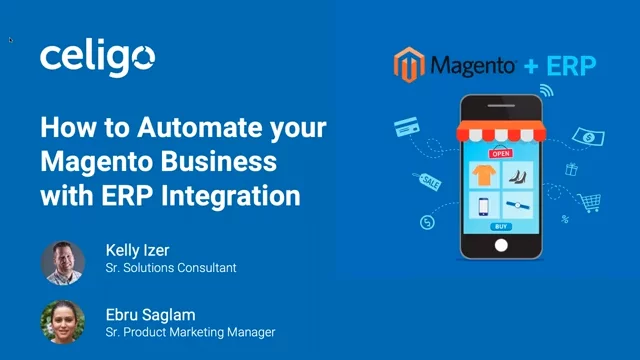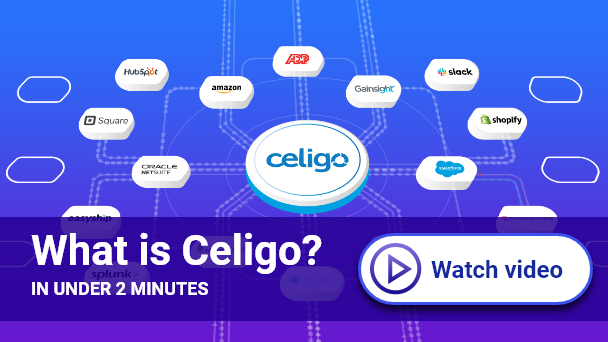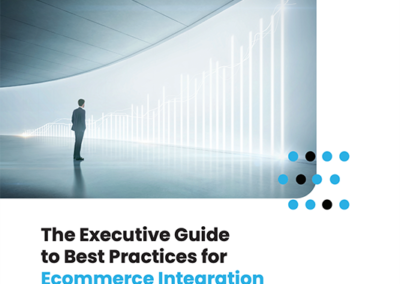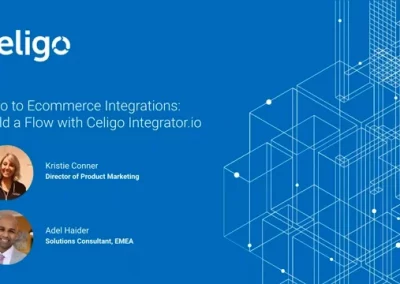So let’s get started here. So if you can all put your cell phone mute, that would be great. So my name is Ebru and I work in Product Marketing at Celigo and I’m here today with Kelly from our Solutions Consulting team. So when it comes to integrations, Kelly is our in-house expert and today we will talk about how you can automate your Magento business with ERP integration. So if you have any questions during the session, please type them into the chat window. So, yes. First, some background on Celigo. We are an iPaaS integration platform as a service company. In our platform, any app can be connected to any other app with integration and data can be passed across the applications, automating business processes. So we have a deep expertise with e-commerce use cases.So today we have thousands of customers. So you can see some logos here. They’re spread across consumer goods, retail, and manufacturing companies and these businesses, they leverage our platform to automate their e-commerce operations. And on our platform, we offer pre-built integrations for popular e-commerce applications such as Magento, but other than that, also on the platform, you can connect your ERP to Amazon, eBay, Walmart, Returnly, or you can even connect directly to your 3PL. And so we have been recognized within the gardener major quadrant for the past couple of years, and also we are an iPaaS leader on the G2 platform, and most recently, we also made it to the G2 Best Software of 2021 list. And so this selection was purely based on verified customer reviews and this really shows us how much our customers value us. So we appreciate this. So now, yeah, let’s talk a bit about the top challenges in e-commerce order to cash today. So sales orders, these need to be transferred to the ERP system for accounting and also for gaining financial visibility. And inventory levels, they have to be updated across the storefronts and the ERP system not to sell out of stock items to customers. Also to ensure timely procurement decisions within the ERP and then, very importantly, for order to cash, right, orders need to be processed fast for maintaining but also improving customer experience. So now without automation– so all of these processes, they need to be done by manually downloading, uploading data between systems or even keying in the data across the systems and manual processes are, obviously, slow, cause delays but also these are error prone and resource-intensive and these are not scalable. And so this is where integration comes into play. So by integrating Magento into your ERP system, you can completely automate all of these processes and even many others that either that I didn’t mention. For example, you can update your product data from your ERP system into your Magento stores, making sure pricing, product images, descriptions are all up-to-date and then every new order can be sent into your ERP system for fulfillment and tracking information can be automatically sent back into Magento once an item is fulfilled and done. So the good news is that on Celigo’s integration platform– so you can basically connect Magento with any ERP system and so SAGE or Microsoft Dynamics, Acumatica are just a few of the examples. So before I hand it off to Kelly for a demo, let’s talk a bit more about our platform. So as I mentioned earlier– so on the platform, you can connect basically anything and it’s also very intuitive. So the UI really empowers business users to build and manage their own integrations, and we have an integration marketplace, and there are a selection of prebuilt integrations available there for the popular applications and these basically help you get faster time to value. So instead of building integrations from scratch, you can take the existing integrations, customize, configure them as you wish and then automate your processes without any coding. And so the pre built integrations, these typically cover 90 to 95% of the popular use cases. And so these come with prebuilt flows and then if you need anything beyond what is covered with those flows, you can always build additional flows using the platform. And I think one other important aspect of the platform to mention it, is that it also has advanced features for integration, monitoring, and error management and this really makes the maintenance low-cost but also helps you ensure your business continuity. And now I will hand it off to Kelly so that he can walk us through the platform and show us some examples. So let me make you the presenter. Thank you, [inaudible]. Yes, you are the presenter. All right. All right. You should be seeing my screen now. Yes, we can. So what [inaudible] [doing?] this is our integration platform. This is where any integration you would like to build would be presented to you as an end-user. I would like to note that this platform is a “set it and forget it” type application, meaning once you have its setup configured, there is not a need to come in here every day in order to view this. You can have the tool setup such that it will push any kind of exceptions or connection information to your inbox. And then from there, you can take the appropriate steps as necessary. So our tool is completely cloud-based. So it is going to sit in the background, process your data between your different integration points, and move it as necessary. So what you’ll see here within the integration, if I go down the left-hand side, I have menu options to get to many of the key areas within the platform, such as our flow builder, which I can quickly highlight here momentarily. But that’s essentially where we build all the flows as required by business requirements. We have a data loader tool included, which allows you to import local files from your local directory or network drive or such. Under resources here which you’ll see, a user has quick access to the individual areas within the platform, such as connection management. Imports, so the flows that push data into applications. Exports, our tool does have a scripting environment and included within it, meaning you can use JavaScript to write code directly within the platform to transform the data or do whatever is necessary there. That way, we’re really making sure that that data is transformed properly as it moves from application to application. Our tool can support on-premise applications. We do have an on-prem agent that can be used to access those. We have a help area here. Within this help area, this is where we have a link to our knowledge base that has thousands of articles around our integration app. And we also have links to some key areas, a developer’s area. We have office hours that we host weekly. So we have links to that information included there. We also have a What’s New section. I always like to highlight this area because Celigo is dedicated to constantly enhancing and improving the platform. As we improve it, we will make regular releases to push out new features and such. Those are hot releases, meaning there’s never any downtime to an end-user when we push out those new updates and such. But here, you’ll see we give you a link so that you can review the release notes and see what was included there. We also have a very robust ticketing system and support team built around our platform. So if there are any additional questions or issues or such, you can submit a ticket, which would then be responded to accordingly. And then another nice area that I always like to highlight here is our Celigo University. So the Celigo University is a learning module system that we have built around the platform. So this is where users can come in and take courses and basically just little training modules around different areas of the platform. You can watch videos that’ll kind of walk you through different areas, then a little quick sort of, “Hey, which of the quiz did you come for? A comprehension sort of quiz?” It’s optional, but it’s an area to help guide users through becoming more comfortable with our platform as well. And then finally, as we said, our platform is system agnostic, so we can integrate anything to anything. As we build out integrations and work with different systems, what we have here is what we call our marketplace. So this is where we build so what we call template sets, we can make those available. Also, we have what we call integration apps, which are built and managed by Celigo. Basically, they’re 90% complete, right. They support many of the key data flows around some of these platforms. So then a user can install them. And it’s kind of like installing a template from Microsoft Word or such, a quick way to jump in, get you started pointed in the right direction. So for example, here, time out on Magento, if I click on Magento, you’ll see we have these template sets and integration sets around the different Magento environments here that we’ve worked with in the past. So, for example, here you can see the integration apps. Again, these are already prebuilt and sort of off-the-shelf solutions built by Celigo or Celigo-approved partners. Here we have Magento 1 support and Magento 2 support with our integration apps. Then you’ll see these are our template sets. So when you have a license with integrator.io, you then can access these and install them as necessary. So for example, Magento and Acumatica, if you install this, we already have some of the pre-built flows, which I’m going to walk through here momentarily. Magento and Dynamic’s Business Central, Magento, QuickBooks for a couple of templates, so. And we’ve got these QuickStart templates available. Now, when a user installs those templates, what it’s going to do is it’s going to drop one of these integration tiles into your system. When you put that in like you see here if we did Magento and Acumatica, if I click on this integration tile, you’ll see we’re going to go and preload all of these flows for you. By default, they’re turned off. So now, as an end-user, what you can do is, number one, pick and choose which flows you want to use. And these flows are not all-encompassing, right. They’re templates that give you sort of an idea of how flows can be built, point you in the right direction. Or using our platform and our flow builder, you can build out any additional flows you need because we do have access to all the APIs within these different applications. So what we’re going to do, for example, is let’s just look at this top one here, Acumatica or this next one here, Acumatica customers to Magento customers. What our platform does is we go ahead and build out the call here with the API endpoints. So, for example, with Acumatica, we’ve already defined the endpoint to be used, customer, we want to list our customers. Now, you as an end-user, if you want to modify this, you could come in here and change this. So if I select the customer here, you’ll see our flow builder here for the export opens up and says, “Great, all right, what do you want to work with? What other object?” And here, like with Acumatica, we have access to all your standard objects there. So we would define that. You can define your operation. Do you want to list all customers, list a specific customer? Then what that’s going to do is if we preview that, that will return an object from the tool. And so it’ll give us all of our info, customer ID, customer name, and whatever fields are returned from that API call. Once we have that data out, we can then transform it, filter it. This is where you then have the ability to use JavaScript and such. But now our tool says, “Great. Where do you want to post that data to?” So just like on the Acumatica side working on the Magento side and what we have access to here is we can work with all the APIs there within the platform [inaudible] order. So depending on what you want to post data to, you can post it to that endpoint then perform the appropriate action as necessary. Once you have your action defined, this is where you map your fields between the applications. So down the left-hand side, you’ll see your field as presented from your source application. On the right-hand side, these are the destinations because this is a known application. At Celigo, we know what fields are required. So you’ll see there we put locks on there to make sure that those are populated. If you need to load in additional fields, you can see we’ve got the dropdown showing all fields available so you could select that accordingly. And then on your source, you’ve got a list of your fields and you could pump it there. You can use a dropdown. We could also type ahead. The tool gives the user the ability to hard code values. We can even build lookups to find values from other systems. We can also do different functions and we can compare statements on date formatting, if-else statements, and such. So what we’re really doing is making sure that the tools are in place in order to make sure the data is being formatted properly as it passes from one application to the other. So once that’s done, really that’s sort of the basis of an integration app there– or not an integration app but an integration flow. So if I close out of that, you’ll see that your first flow that’s been developed there. So the nice thing is this is not a black box. What that means is you, as an end user or whomever you would like, can come in here and make changes as necessary. You’ll have a dashboard view available to you, so as flows are being executed and processing data, this is where you can see which flow ran at what time, how long it took, and such. You have access to see what connections are supporting that integration. As stated before, this is a set it and forget it type tool. So what that means is, again, it’s going to run in the background. This is where you can configure what flows you want to be notified of. You can be notified of select flows or all flows. We also have connection management, meaning our tool will sit there and prior to processing the data, we’re first going to ping that endpoint and ensure that it’s online. If it is not, we’re going to queue up that data until the connection comes back online. That way we ensure that there’s no data loss due to a down connection. And you can also have those alerts pushed to your inbox if one of those connections goes offline. You can also add in additional users into the integration app and they can be either managed or monitor rights. So from a management perspective, it’s very easy to manage, monitor, and maintain these flows. You can come in here for any flow that’s been turned on. You as an end user then can control the scheduler. So you can say, “Great, I want this to run,” and you can define the frequency, like I want to run every hour. I can specify a start and end time. I can specify a day of the week I want those flows to be executed on. For any batch-based flow, you can also run them on demand at any time by selecting the run now function, which would then kick that flow off and execute it in real-time if necessary. At a high level, this is what our integration platform is going to support for you. We can support different applications, so here, you see this was Acumatica and Magento. We can also do, as I mentioned earlier, Dynamics- Magento, NetSuite-Magento, and really you can use Magento to anything you would like using our tool. As we stated, we are system agnostic, so it can be used to push data from any application to any application. All right. So at this time, I’ll turn it back over to Ebru. If you do have any questions, please post those in the chat window. We’ll be glad to answer those and help answer any questions you may have. Thank you so much, Kelly. Yeah. Thank you. [silence] Okay. So as Kelly mentioned, if you have any questions, type them into the chat window. So now, here, I have a customer story. So Scarpa is a very well-known outdoor footwear brand, and they’re direct to consumer sales channel was through their Magento stores, and they were having challenges with manually processing orders. So they wanted to connect Magento to their ERP system and automate order processing. So instead of going for an integration platform such as Celigo, they initially actually outsourced this, and they developed the custom API integration. So, however, over time, they saw that this integration was unreliable. It wasn’t really scaling well, and it was causing delays and errors, providing poor inventory visibility. So just some notes there actually with any custom API integrations or third party point-to-point integration. Something we often hear is that these are not scalable, especially during holiday sales when there are an unexpected large number of orders, so these don’t really have the technical robustness to process these. So on the other hand, an iPaaS such as Celigo can easily handle those increasing loads. So coming back to SCARPA, they switched to Celigo’s iPaaS and went for one of our pre-built Magento integrations that Kelly just showed us on the marketplace. So with the new integration, they were able to accelerate their order processing. So as a result, they improved customer experience, but also, they improved their operational efficiency. And then also, they were now able to get near real-time visibility into their inventory levels preventing over-selling goods to their customers. And another benefit they got with this automation was now, their staff actually got some time back to focus on new tasks and opportunities instead of having to deal with manually downloading, uploading, and [inaudible] data between the different systems. So to learn more about the Scarpa case study and also to learn about some other customer stories we have, you can visit our website at celigo.com and check under resources. So [also?] have some other webinars coming up, so you can also learn about those and sign up. And so another thing I would like to mention is also on the resources, so we have some really useful guides and e-books for e-commerce. So especially if you’re just getting started with integration, so I would recommend that you download the Executive Guides to Best Practices for E-commerce Integration. So this guide, it provides an integration roadmap for e-commerce business processes and also shows you how to get started with your integrations. And now, we will be moving to a question. So if you have any questions, so now, you can type them into the chat window. So, yeah, let’s see here. So one question I see is, can all the flows run in real time, and then can the flows be customized to be triggered based on certain events? Is that something you can answer, Kelly? So we can’t support webhooks, right? So if that external application supports webhooks and such to execute real time flows, yes, those flows can be built in that manner in order to process the data in real time if necessary. What was the second half of that [inaudible]? Can they be [crosstalk]? Second half was, can the flows be triggered based on certain events? Well, that would be based on the application [inaudible]. So in Magento, that would be your webhook, right? You would go into Magento, set up a webhook to trigger on key events like, “Oh, there is an order created. I want to push it to that particular webhook.” So if the endpoint does support it, the answer is yes, it can be built in real time to move the data. Otherwise, it would be a batch-based process. Great. Thank you. So another question is, so can multiple administrators be added to the account? Yes, you can have multiple admins now. And again, you can control different levels. You can have managers, which can manage an integration, make changes. You can have admins. Admins can add in additional users and make licensing changes and such. And then you can also have users just as monitor, which means they can monitor it, they can see errors, they can address errors as necessary. And that’s all the rights they have. So the answer is yes. So another question I see is, have you integrated [to from?] Infor VISUAL manufacturing? So I personally, I’m not sure about this. I have to check. But if the application has a level of connectivity, I mean, we can technically connect to any application on our platform. Kelly, do you have any visibility into that for Infor VISUAL manufacturing? I know that we have scope projects with Infor before, so we have scoped those out based on the APIs and such available. I’m usually pre-sales, so I don’t see post-go-live the projects, but I know we have scoped out projects and done that with Infor before. Specifically manufacturing, we have to look internally to be 100% sure exactly which version. Okay. And we can definitely get back to you after the webinar, so we just need to check with our teams. So another question is, “Is it possible to automate 3PL order processing with Magento ERP integration?” And so I can answer this. Yes, I mean, similar to the way you can connect Magento to an ERP system, you can also connect your ERP system to your 3PL and maybe their warehouse management system, and then sync any incoming orders from Magento to your ERP, and then sync the orders from your ERP to the 3PL. Or if you want to bypass the ERP system, we also see some customers, they just directly integrate between their storefronts, such as Magento, to their ERP. So yeah, different options are available there. And so another question I see here is, “So can you talk more about integration, monitoring and error management? So is it possible for a business user to really manage this without any IT help?” Is that something you want to answer, Kelly or–? Well, I’m thinking of how to answer that. I mean, you have to understand what is involved with the error in order to correct it. So if your team has the resources, you can manage your errors and address them accordingly. If you do not have the IT resources, we do have a support level available – I think it’s premium-level or such – where we can have resources to help you in regards to resolving errors and doing error-management and monitoring for you as well. So we can assist there if necessary. Yes, and I mean, I personally know that we have, actually, many customers and business-user roles that are actually just doing this integration monitoring management by themselves. So it is possible. So another question here is, “Can you [think?] an ERP to Magento stores with different currencies?” And I will, again, let Kelly answer this one. The answer is yes. Basically, what you’re going to have there is you most likely have your multiple Magento stores connected, and when we connect to those stores, it’s going to define the currency being used for the store. So at that point in time, we could grab that data. When we post it into ERPs, most ERPs will have a currency designator, and then we can post the appropriate currency that that transaction is being received in. So the answer is yes. Okay, great. Thank you very much, Kelly. And I don’t think we have any other questions. So if you have any questions after the webinar, please feel free to reach out to us. You can email us at
[email protected], or you can just go to our website and contact us through the chat window. So we are also interested in hearing about your integration challenges. So let us know, and we would be happy to help you. So thanks again for joining us, and I hope you have a nice rest of your day. Bye everyone.







